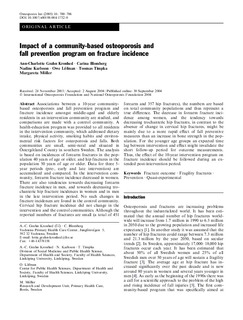| dc.contributor.author | Grahn Kronhed, Ann-Charlotte | |
| dc.contributor.author | Blomberg, Carina | |
| dc.contributor.author | Karlsson, Nadine | |
| dc.contributor.author | Löfman, Owe | |
| dc.contributor.author | Timpka, Toomas | |
| dc.contributor.author | Möller, Margareta | |
| dc.date.accessioned | 2017-06-07T12:40:02Z | |
| dc.date.available | 2017-06-07T12:40:02Z | |
| dc.date.issued | 2005 | |
| dc.identifier.citation | Grahn Kronhed, A-C., Blomberg, C., Karlsson, N., Löfman, O., Timpka, T. & Möller, M. (2005) Impact of a community-based osteoporosis and fall prevention program on fracture incidence. Osteoporosis International, 6(6), s. 700-706. | |
| dc.identifier.uri | http://hdl.handle.net/11250/2445118 | |
| dc.description | Artikkelen rapporterer en studie hvor hensikten var å utforske om kommunebasert intervensjonsprogram for osteoporose og fallforebygging er assosiert med reduksjon av forekomst på overarms- og hoftebrudd eller ikke blant middelaldrende og eldre. | |
| dc.description.abstract | Associations between a 10-year community-based osteoporosis and fall prevention program and fracture incidence amongst middle-aged and elderly residents in an intervention community are studied, and comparisons are made with a control community. A health-education program was provided to all residents in the intervention community, which addressed dietary intake, physical activity, smoking habits and environmental risk factors for osteoporosis and falls. Both communities are small, semi-rural and situated in Östergötland County in southern Sweden. The analysis is based on incidences of forearm fractures in the population 40 years of age or older, and hip fractures in the population 50 years of age or older. Data for three 5-year periods (pre-, early and late intervention) are accumulated and compared. In the intervention community, forearm fracture incidence decreased in women. There are also tendencies towards decreasing forearm fracture incidence in men, and towards decreasing trochanteric hip fracture incidences in women and in men in the late intervention period. No such changes in fracture incidences are found in the control community. Cervical hip fracture incidence did not change in the intervention and the control communities. Although the reported numbers of fractures are small (a total of 451 forearm and 357 hip fractures), the numbers are based on total community populations and thus represent a true difference. The decrease in forearm fracture incidence among women, and the tendency towards decreasing trochanteric hip fractures, in contrast to the absence of change in cervical hip fractures, might be mainly due to a more rapid effect of fall preventive measures than an increase in bone strength in the population. For the younger age groups an expected time lag between intervention and effect might invalidate the short follow-up period for outcome measurements. Thus, the effect of the 10-year intervention program on fracture incidence should be followed during an extended post-intervention period. | |
| dc.language.iso | eng | |
| dc.title | Impact of a community-based osteoporosis and fall prevention program on fracture incidence | |
| dc.type | Journal article | |
| dc.type | Peer reviewed | |
| dc.rights.holder | Grahn Kronhed, Ann-Charlotte | |
| dc.source.volume | 6 | |
| dc.source.journal | Osteoporosis International | |
| dc.source.issue | 6 | |
| dc.identifier.doi | 10.1007/s00198-004-1732-0 | |
